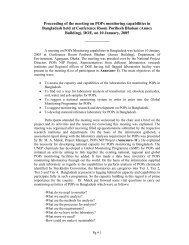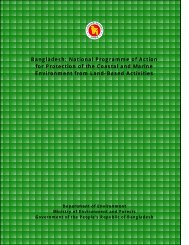Draft CMP HH - the Department of Environment
Draft CMP HH - the Department of Environment
Draft CMP HH - the Department of Environment
Create successful ePaper yourself
Turn your PDF publications into a flip-book with our unique Google optimized e-Paper software.
Management Actions<br />
Coastal and Wetland Biodiversity Management Project BGD/99/G31<br />
Hakaluki Haor <strong>Draft</strong> Conservation Management Plan<br />
• Identify all sources <strong>of</strong> water used for irrigation purposes<br />
• Document all forms <strong>of</strong> irrigation practised in <strong>the</strong> ECA including traditional, indigenous, and<br />
contemporary<br />
• Identify and document <strong>the</strong> ecological and socio-economic impacts associated with each different<br />
form <strong>of</strong> irrigation<br />
• Identify <strong>the</strong> type <strong>of</strong> crop requiring <strong>the</strong> most amount <strong>of</strong> water and conversely that which requires<br />
<strong>the</strong> least<br />
• Identify sites in <strong>the</strong> ECA that are prone to drought and where <strong>the</strong> pressure for irrigation is likely<br />
to be highest<br />
• Provide technical, and where feasible financial, support to farmers in <strong>the</strong> adoption <strong>of</strong> irrigation<br />
strategies which are less harmful to <strong>the</strong> environment<br />
• Identify and promote <strong>the</strong> use agricultural and horticultural crops that are <strong>the</strong> least dependent on<br />
excessive irrigation<br />
• Provide technical, and where feasible financial, support to farmers in <strong>the</strong> adoption more drought<br />
tolerant agricultural and horticultural varieties<br />
• Support <strong>the</strong> development <strong>of</strong> local by-laws which restrict or prevent <strong>the</strong> use <strong>of</strong> environmentally<br />
unfriendly irrigation practices<br />
Primary Outcome/ Output<br />
• Irrigation is regulated and managed in a sustainable manner<br />
Constraints<br />
• Unregulated irrigation throughout <strong>the</strong> ECA is widespread and well entrenched and bringing<br />
about change is likely to be slow and difficult<br />
7.2.13 Medicinal Plants<br />
The medicinal plants <strong>of</strong> Hakaluki Haor once an integral part <strong>of</strong> <strong>the</strong> swamp forest ecosystem have<br />
now largely been incorporated into <strong>the</strong> homestead gardens <strong>of</strong> <strong>the</strong> local communities living in and<br />
around <strong>the</strong> ECA. Some <strong>of</strong> <strong>the</strong> most common include Neem (Azadirachta indica), Arjun (Terminalia<br />
arjuna), Aggor (Aquillaria agallocha), Aonla (Phyllanthus emblica), Damur (Ficus Lispida), Tulni<br />
(Ocimum sanctum), Thankuni (Centella asiatica), Bohera (Terminalia Bellirica), and Haritaki<br />
(Terminalia chebula). These plants are used by local village doctors and o<strong>the</strong>rs skilled in <strong>the</strong><br />
knowledge <strong>of</strong> <strong>the</strong>ir <strong>the</strong>rapeutic applications to treat many common ailments. The sale <strong>of</strong> <strong>the</strong>se plants<br />
is also used to supplement <strong>the</strong> incomes <strong>of</strong> many poorer families.<br />
Wild medicinal plants in Hakaluki Haor are now becoming increasingly rare largely because most<br />
<strong>of</strong> <strong>the</strong> original swamp forests have been cut-down, and also as a result <strong>of</strong> over-harvesting. The<br />
conservation <strong>of</strong> both wild and homestead garden medicinal plants will not only benefit local<br />
communities, but is also important for biodiversity conservation.<br />
Management Actions<br />
• Collect socio-economic data concerning medicinal plants <strong>of</strong> <strong>the</strong> Haor including information on:<br />
� Use <strong>of</strong> each plant in treating ailments<br />
both for humans and farm animals<br />
such as chickens, goats, cows, buffalo,<br />
sheep, fish etc.<br />
Prepared by UNOPS Consultant Mr. Sulma Warne August/ September 2005 for Project BGD/99/G31 32





